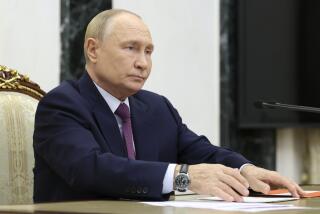2 Sides Set to Ratify ‘70s Nuclear Treaties : Arms control: Years later, two agreements to limit underground testing will finally take effect.
- Share via
WASHINGTON — In one of the longest-running sagas in arms control history, President Bush and Soviet President Mikhail S. Gorbachev will sign protocols this week implementing two nuclear-test treaties reached a decade and a half ago but never ratified into law.
Taking up only two pages, the treaties limit underground nuclear tests for both military and non-military purposes and have been honored by both nations even though the final details were not resolved.
But the protocols to implement them fill 220 pages each, an indication of the technical and political issues that have bedeviled superpower efforts to curb nuclear tests since the treaties were signed in 1974 and 1976.
And while approval of the two protocols probably will assure ratification of the treaties, the United States and Soviet Union remain at odds over what comes next. Moscow wants to ban nuclear tests totally, rather than just limit them. But Washington insists that some testing will be necessary as long as nuclear weapons are required for deterrence.
Nuclear testing was the subject of the first U.S.-Soviet arms agreement in 1963. Responding to an international clamor to halt aboveground tests that rained radioactive fallout around the globe, the two nations agreed to ban tests in the air, in water and, later, in outer space.
The United States at the time was also prepared to limit tests underground but demanded on-site inspection to make up for the inadequacies of monitoring tests from distant seismic stations. Seismic waves from test blasts are hard to distinguish from earthquakes.
But the Soviets objected, saying that they feared the on-site inspectors would be spies.
More than a decade passed before the Threshold Test Ban Treaty was signed in 1974. It limits underground nuclear weapon tests to 150 kilotons, or the equivalent of 150,000 tons of TNT.
In 1976, the 150-kiloton limit was extended to non-military nuclear blasts, for such purposes as excavating canals or developing petroleum deposits, in the Peaceful Nuclear Explosions Treaty.
But Richard M. Nixon resigned as President before he could submit the 1974 treaty for Senate approval. Gerald R. Ford declined to send forward either treaty after he came under conservative attack from Ronald Reagan in the 1976 GOP primary.
Ford’s successor, Jimmy Carter, wanted to leapfrog both treaties by negotiating a comprehensive test ban forbidding all nuclear weapon tests. But when the Soviets invaded Afghanistan in 1979, the old agreements, as well as the new negotiations, were put on hold.
As President, Reagan accused the Soviets of “probably” cheating on the 1974 and 1976 agreements. He insisted on stiffer verification safeguards, including on-site inspections, before he would submit the treaties for ratification.
Most specialists dispute the cheating charge, attributing it to Reagan’s political suspicions and to technical errors in monitoring seismic signals. But the Soviets eventually agreed to new talks in 1987, on condition that--upon ratification of the old treaties--talks would begin to further limit underground tests with the ultimate goal of banning them.
The principal dispute in the protocol negotiations was how best to measure the size of a test explosion. The Soviets insisted that seismic instruments implanted on or near the test site were sufficient when coupled with detailed information on test site geology.
But the United States demanded the use of a new, intrusive and costly on-site measuring technique in which an electric cable is lowered into a parallel hole located within 100 feet of the shaft in which the nuclear blast occurs.
Joint U.S.-Soviet experiments were conducted using both methods, and the seismic system was found to be at least as accurate as the U.S.-preferred technique. But the United States remained adamant, and a compromise was reached in which both techniques could be used.
Proponents of a comprehensive test ban endorse the new protocols as a means of moving beyond the old treaties to negotiate further testing limits. One goal is a ceiling on the number of tests. Another is to lower the threshold. The hope is that new weapon development would become more difficult, if not impossible.
While the most vocal public demands for test bans over the years have come from the United States and Western Europe, Soviet citizens under glasnost , Gorbachev’s policy of openness, are finally catching up and joining with testing opponents from the United States and other nations.
Popular opposition at Semipalatinsk, the test range on Kazakhstan’s bleak steppes, apparently forced the Kremlin to phase out testing there. Tests would only occur in Novaya Zemlya, a remote island near the Arctic Circle.
Times staff writer John-Thor Dahlburg in Moscow contributed to this report.
U.S. and Soviet Nuclear Tests Key Points of New Testing Protocois Under terms of unratified 1974 and 1976 treaties, nuclear weapons test and non-military explosions are limited to 150 kilotons. For the time, the United States and Soviet Union will have the right to perform on-site monitoring of nuclear tests above 35 kilotons. Each side also can measure nuclear tests above 50 kilotons by seismic instruments or by hydrodynamics.
Source: Natural Resources Defense Council
More to Read
Sign up for Essential California
The most important California stories and recommendations in your inbox every morning.
You may occasionally receive promotional content from the Los Angeles Times.













